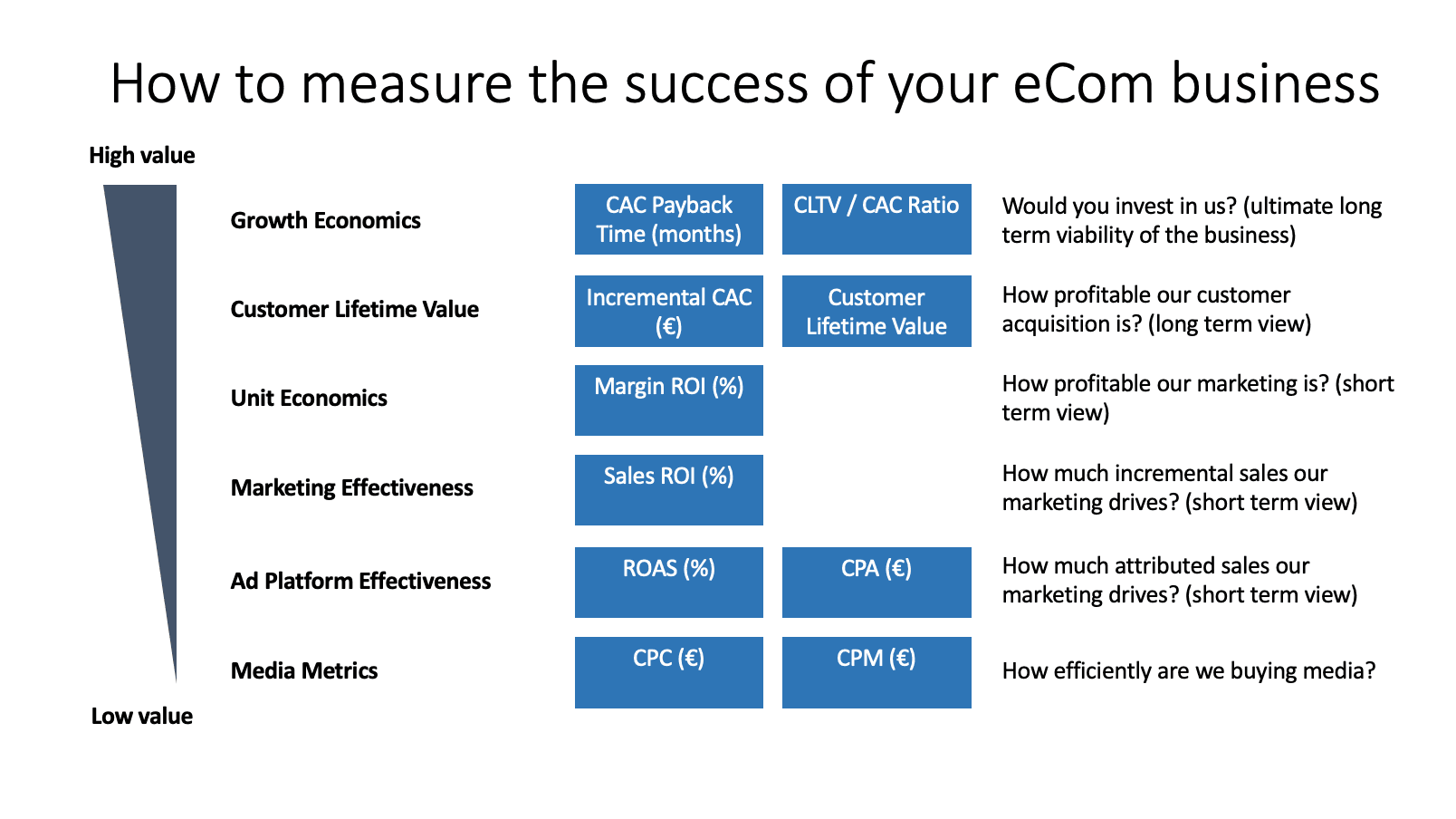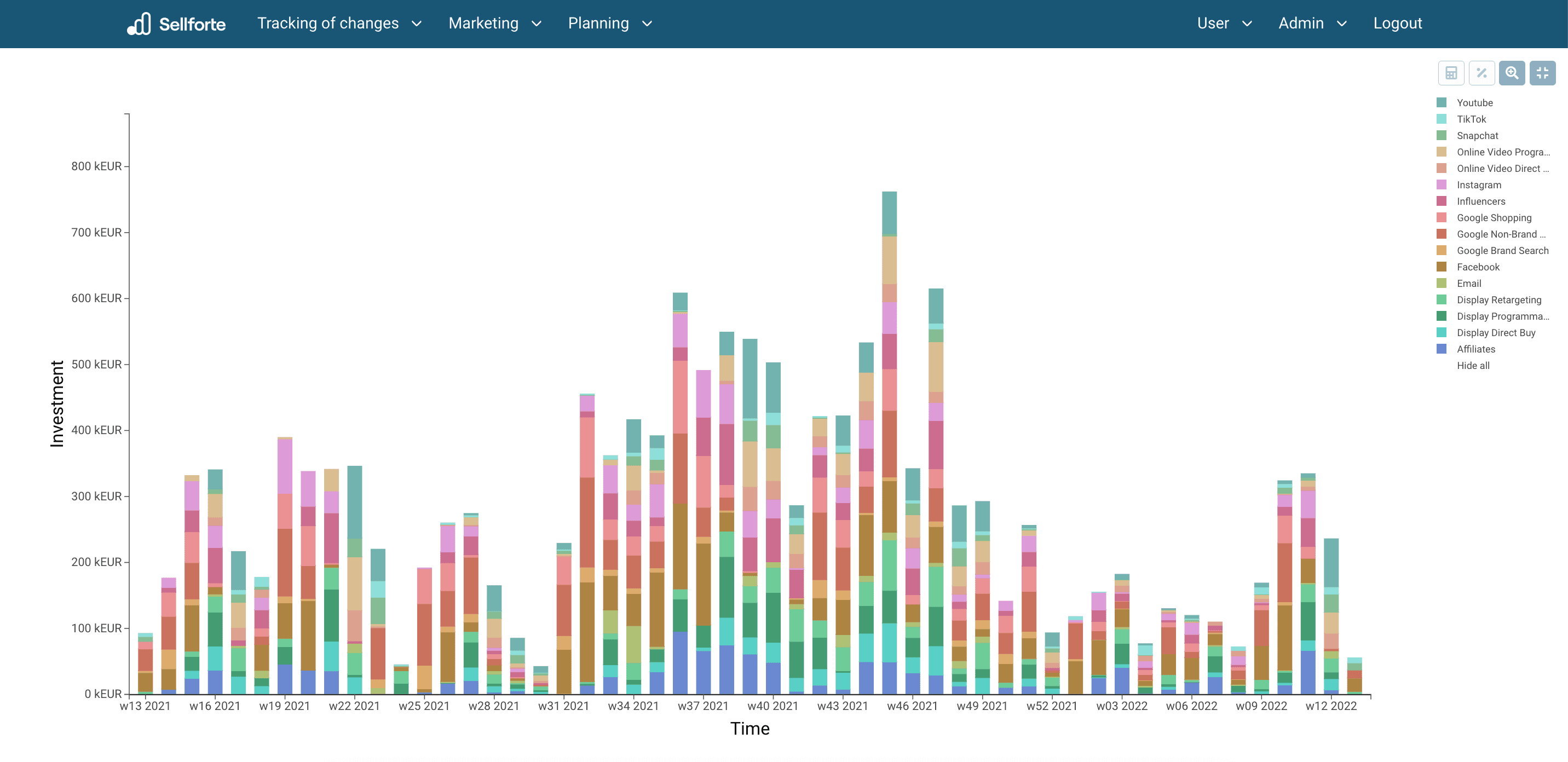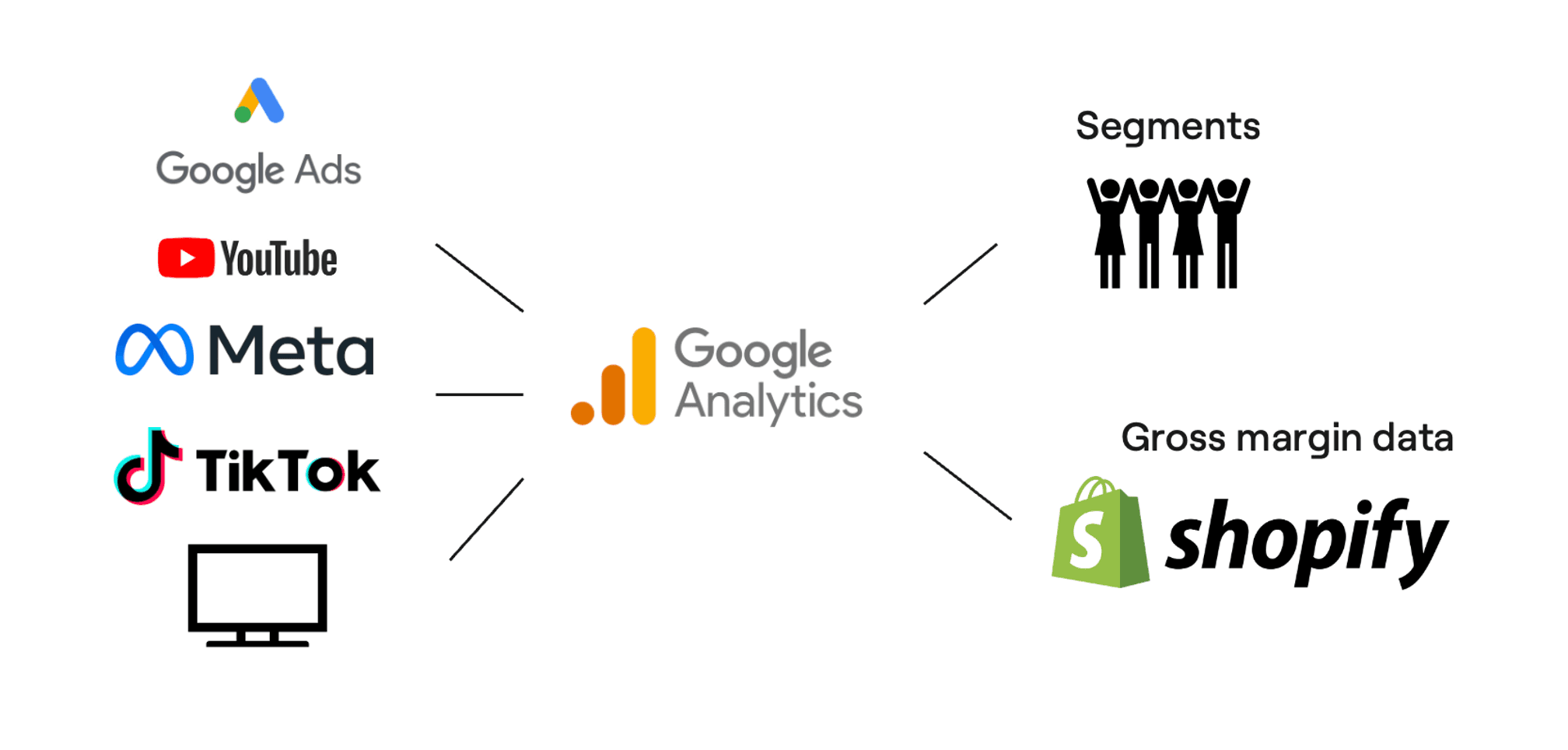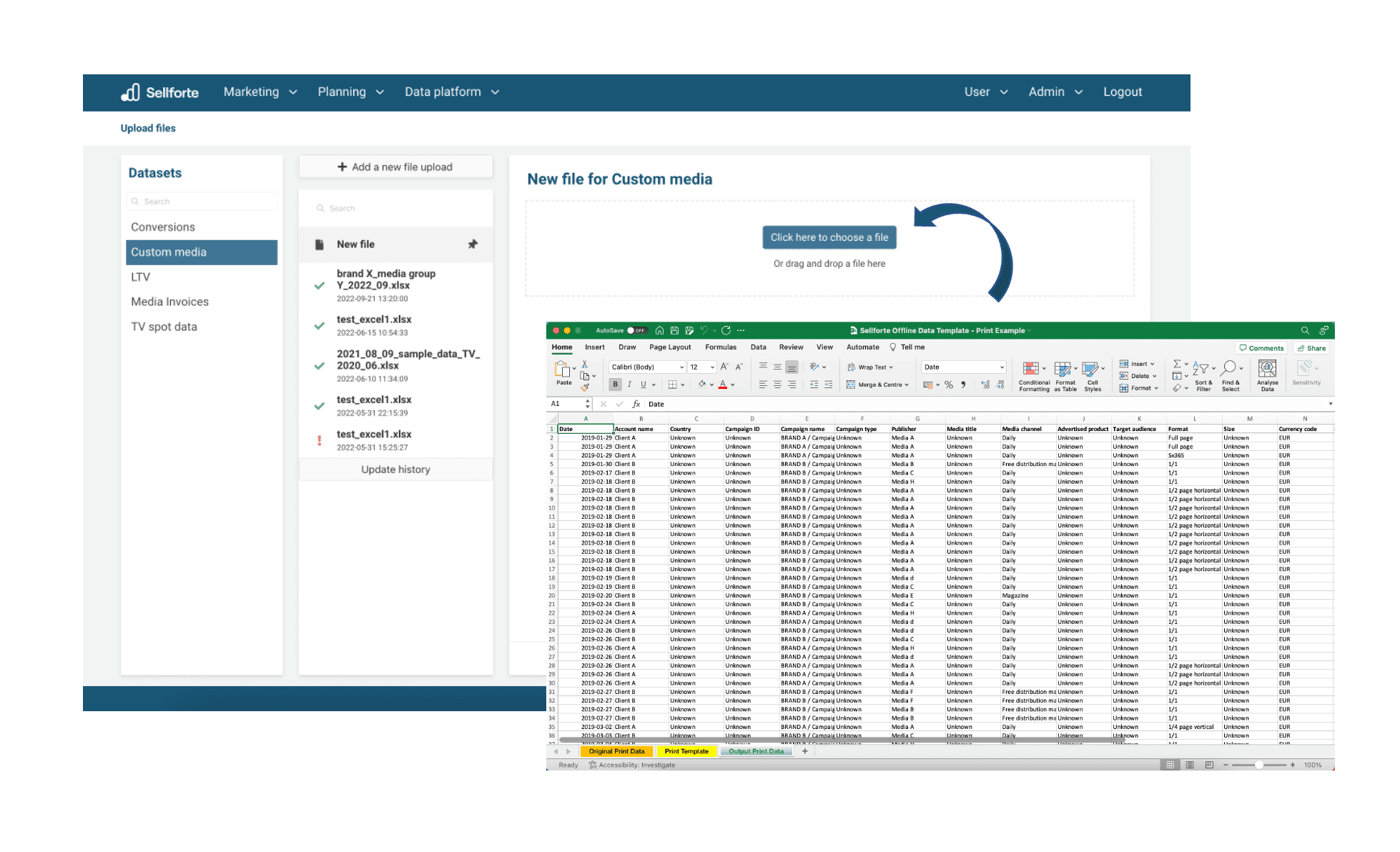Blog
Why optimize eCommerce KPIs with MMM? Part 1: Challenges and opportunities
September 04, 2023 | Juha Nuutinen, Paul Arpikari, Carmen Bozga

For decades, Media Mix Modeling (MMM) has been seen as a luxury for large enterprise companies, focusing on measuring the effectiveness of media investments in relation to sales. While this approach and its associated KPIs might suit the corporate landscape, it often proves too abstract and slow-moving for the dynamic world of eCommerce.
In this first part of our comprehensive series on eCommerce KPI optimization with MMM, we'll go in-depth into the challenges that eCommerce businesses face when measuring KPIs and how MMM offers solutions. Additionally, we'll provide an overview of the most relevant KPIs for eCommerce into a short dictionary like manner. To help you evaluate the health of your eCommerce business, we've curated a concise list of questions. As you progress through this series, these questions will help you concentrate on the aspects you find important for your business. Ultimately, we will go over which KPIs deserve your attention for optimization and which can be set aside.
Initially, we'll tackle the fundamental KPIs, both in terms of measurement ease and their interconnected nature. Some KPIs are intrinsically linked to others, necessitating a holistic system where all marketing strategies seamlessly align for optimal profitability. We'll expand on this interconnectedness in subsequent parts of our series.
Important eCommerce KPIs for Media Mix Modeling
Before we dive deep, it's essential to ensure we're all on the same page (pun intended). Here's a short "KPI dictionary" to keep handy as you read through our series.
- Key Performance Indicators (KPIs): Metrics used to evaluate the success of an activity or process.
- Media Mix Modeling (MMM): A methodology to measure the impact of media investments on sales and then forecast the impact of future marketing campaigns.
- Revenue incl. VAT before returns (Rev. incl. VAT pre-returns): The total revenue generated, including Value Added Tax, before accounting for any product returns.
- Revenue excl. VAT before returns (Rev. excl. VAT pre-returns): Total revenue generated excluding Value Added Tax, and before any product returns are factored in.
- Revenue from customers who did not accept analytics cookies (No-cookie Rev.): This refers to the earnings generated from users who did not consent to analytics tracking during their session on the website.
- Revenue excl. VAT after returns (Rev. excl. VAT post-returns): Total revenue after deducting both Value Added Tax and returned product values.
- Gross Margin after returns (GM post-returns): This is the profit a company makes after deducting all costs directly associated with making a product, and after accounting for returned products.
- Customer Lifetime Value (CLV/CLTV): An estimate of the total worth of a customer to a business over the entirety of their relationship.
- Customer Acquisition Cost (CAC): The total cost spent on acquiring a new customer. This includes all costs of advertising, marketing, and any other resources that contribute to securing a new customer.
- Incremental Customer Acquisition Cost (Incremental CAC): The additional cost incurred to acquire one additional customer, considering all marketing and associated expenses.
- Return on Ad Spend (ROAS): Measures the gross revenue generated for every dollar spent on advertising. It’s a metric to evaluate the effectiveness of a specific advertising campaign.
- Advertising Cost of Sale (ACOS): Used primarily in the context of Amazon advertising, it represents the ratio of ad spend to targeted sales. It helps advertisers understand how much they spend on advertising for every dollar of revenue generated.
- Cost Per Acquisition (CPA): The total cost of acquiring a new customer through a specific marketing channel or campaign. It can be seen as a subset of the broader CAC but focused on a specific initiative.
- Average Order Value (AOV): The average amount of money each customer spends per transaction. It gives insight into customer spending habits.
- Cost Per Mille (CPM): Often known as Cost Per Thousand, it represents the cost an advertiser pays for 1,000 impressions (or views) of an advertisement. It's a common metric in display advertising to gauge the cost-effectiveness of a campaign.
Why Tracking and Optimizing KPIs is Crucial for E-commerce Businesses
E-commerce businesses thrive on understanding their performance in real-time. Keeping a pulse on KPIs isn’t just about numbers—it's about translating those numbers into actionable insights. When e-commerce businesses consistently track KPIs, they can immediately identify both strengths to double down on and weaknesses to address, ensuring they remain agile and responsive to market demands.
Moreover, optimizing these KPIs directly correlates with enhanced profitability. For instance, understanding metrics like Average Order Value (AOV) or Customer Acquisition Cost (CAC) can empower a business to make informed decisions around pricing, marketing strategies, or customer retention programs. Adjustments grounded in reliable data invariably lead to increased sales and better ROI.
Lastly, in an age where competition is just a click away, KPIs provide businesses with a competitive edge. They offer a clear roadmap to customer preferences, behavior, and trends.
Challenges eCommerce Businesses Face When Tracking KPIs
The digital age has brought us a multitude of platforms and tools, each promising precise metrics and insights. However, for many e-commerce businesses trying to holistically track their KPIs, several roadblocks emerge. From our experience, there are four distinct challenges that many grapple with:
Harmonizing Media Reporting: One of the most significant challenges is the absence of a unified dashboard that amalgamates all pertinent marketing data. With different ad platforms offering unique metrics, comparing them becomes a daunting task. These diverse fields demand harmonization before they can be synthesized, and crafting such a comprehensive system is both costly and time-intensive for independent businesses. As previously emphasized, KPIs should ideally work in tandem, offering a composite view of a business's efforts
Enriching Web Analytics Data: Web analytics tools, like Google Analytics, provide a vast array of data. Still, they often fall short by not capturing certain critical dimensions readily available in CRMs, such as distinguishing between new versus returning customers, country-specific data, and gross margins. Furthermore, Google Analytics doesn't account for conversions from users who decline analytics cookies, which can constitute a whopping 20-50% of the total sales. Pairing key metrics like Customer Lifetime Value (CLV) with Gross Margin is virtually impossible without leveraging eCommerce-specialized MMM solutions that can take these topics into account.
Offline Media Measurement: In today's digitally-driven e-commerce landscape, businesses heavily rely on web analytics tools for vital performance insights. Yet, a significant blind spot appears when assessing the influence of offline media. These tools, even sophisticated marketing attribution solutions, stumble when it comes to attributing online sales or traffic to offline campaigns, whether they're billboard advertisements, print media, radio spots, or television commercials. This creates a stark challenge. Without tangible data linking offline promotional efforts to online outcomes, optimizing offline channels becomes akin to navigating in the dark. Businesses risk either undervaluing their traditional media investments or pouring money into channels without understanding their true ROI. This evident disconnect between online analytics and offline impact underscores the crucial need for a more encompassing measurement approach. Only then can e-commerce businesses grasp and optimize the full spectrum of their marketing strategies.
Media Mix Optimization: eCommerce businesses continuously grapple with optimizing their media mix for different seasons, especially when aiming to harmonize various advertising channels. Several pain points emerge in this pursuit:
- Lack of Comprehensive Tools: There's a glaring absence of tools adept at cross-advertising channel optimization. Sole reliance on targets like Return on Ad Spend (ROAS) or Cost Per Acquisition (CPA) is fundamentally flawed. These metrics, while insightful, often fail to capture the nuances and interconnectedness of a multi-channel advertising strategy.
- Unrevealed Marginal ROI: Ad platforms, in their current form, remain opaque about critical insights. For instance, they seldom disclose the marginal ROI of the last dollar invested. This lack of granularity hampers advertisers' ability to make incremental budgetary decisions.
- Varied Incrementality: Different advertising channels demonstrate varied incremental benefits. The gains from prospecting campaigns might significantly differ from retargeting efforts. Similarly, brand-centric searches might not yield the same ROI as generic ones. Recognizing and navigating these differences is crucial for optimizing ad spending across channels.
- Blind Spots in Web Analytics: Tools like Google Analytics present another challenge. They fail to allocate due credit to awareness channels, which play a pivotal role in shaping consumer perceptions and driving initial interest. Without recognizing the value of these channels, businesses might misjudge their media mix's effectiveness.
How does MMM solution solve the challenges eCommerce businesses face when tracking KPIs?
MMM stands out as a beacon for e-commerce businesses swimming in a sea of KPI tracking challenges. Let's break down how MMM presents solutions to the issues presented above:
Harmonizing Media Reporting
One of the cornerstones of Sellforte’s MMM solution is its ability to harmonize diverse data sources, making it easier for businesses to get a consolidated view of their performance metrics. With Data Connectors and specifically for eCommerce built data analytics pipelines, data streams are seamlessly integrated, offering a unified and intuitive visualization of key insights comparing Google Analytics and MMM attributed sales.

MMM systems, keeping up with the dynamic digital landscape, extend support for popular data connectors like Supermetrics and Funnel. This ensures that businesses can tap into their existing data streams without the need for major overhauls.
MMM integration between these connectors offers standardized data schemas, pipelines, and outputs. This means data from varied sources gets translated into a consistent format, ready for analysis. The elimination of discrepancies across platforms and channels facilitates more accurate and actionable insights.
Results from platforms such as Google Analytics can easily be integrated into MMM, ensuring that the insights offered by these tools are effectively incorporated. This automation ensures there's no manual intervention required, simplifying the tracking process.
Perhaps one of the most compelling advantages of adopting MMM is its efficiency. There's no need for dedicated data engineers or significant resource allocation from the customer's end. The system is designed to be plug-and-play, ensuring e-commerce businesses can focus on drawing insights and formulating strategies rather than getting slowed down by technical complexities.
Enriching Web Data Analytics
Web analytics data, as crucial as it is, often provides just a slice of the larger performance pie. Enriching this data, therefore, becomes paramount for e-commerce businesses to gain comprehensive insights. The Sellforte Data Platform stands out as a potential solution to this challenge. Here’s how:
One of its standout features is its ability to work with diverse data types. Regardless of the format or source of your data, the platform offers a seamless upload mechanism. This means businesses aren't restricted to a specific data type or format, ensuring a more holistic data pool for analysis.

CRM systems, treasure troves of customer insights, often exist in isolation from web analytics tools. The Sellforte Data Platform bridges this gap. It supports linking valuable CRM data – whether it's gross margin, customer segments, or country-specific data – with Google Analytics. The CRM linking capabilities ensure a more rounded view of customer behavior, preferences, and trends.
MMM can help you integrate your data with Leading eCommerce Platforms. Recognizing the dominance and popularity of platforms like Shopify in the e-commerce arena, the Sellforte Data Platform offers out-of-the-box integration capabilities. By connecting directly with these e-commerce platforms, businesses can effortlessly merge sales, product, and customer data with their web analytics metrics.
Offline Media Measurement
Even for eCommerce brands, the importance of accurately measuring offline media's impact cannot be understated. While the majority of tools fall short in this endeavor, the Sellforte Offline Data Template emerges as a powerful solution. Here's how it addresses the offline media measurement challenge:
- Efficient Ingestion and Modeling: The Sellforte Offline Data Template is specifically designed to incorporate and model offline data. Instead of treating offline metrics as an afterthought, the tool ensures that data from offline campaigns gets seamlessly integrated into the broader marketing data set.
- Self-Service Data Collection: One of the unique strengths of the Sellforte solution is its self-service offline data template. This user-friendly feature enables businesses to gather and input their offline data, ensuring it aligns with Sellforte's standard fields.
- Bridging Offline and Online: The Sellforte Offline Data Template takes a giant leap in making offline data performance comparable with online channels. No longer does offline media remain an ambiguous entity; MMM allows businesses to discern its influence, harmonizing it with online metrics for a holistic view of marketing performance.

Media Mix Optimization
As businesses continuously navigate the complexities of multi-channel marketing, the Sellforte Media Optimizer emerges as a beacon, helping businesses plan more effective, ROI-driven marketing strategies.
- Strategic Plan Optimization and Sales Prediction: The Sellforte Media Optimizer isn't just about reflection; it's about foresight. By allowing businesses to optimize their media plans, it provides a robust framework to anticipate the outcomes of different scenarios. This is pivotal for marketing strategies, as it enables businesses to anticipate incremental sales, ensuring proactive, data-driven decision-making.
- Future Sales Forecasting: Beyond merely assessing current campaigns, the Sellforte Media Optimizer looks ahead, offering businesses a clear forecast of potential sales. This predictive insight is invaluable for planning, allowing businesses to anticipate demand, align inventory, and streamline operations in preparation.
- Budgetary Predictions for Optimal Allocation: A crucial aspect of media optimization is understanding where to channel one's budget. The Sellforte Media Optimizer demystifies this by providing weekly budgetary needs. This ensures that businesses can allocate funds intelligently, maximizing impact while minimizing waste.
Which KPIs should eCommerce brands prioritize with MMM?
Before diving deep into KPI intricacies, it's essential to grasp the significance of prioritizing them effectively. Not all KPIs are created equal. Their relevance to your business can differ, and therefore, their impact on your bottom line can vary substantially.
Take CPM and CLV, for instance. While CPM is a crucial metric to gauge the cost-effectiveness of your media buying strategies, it's relatively surface-level. It tells you the cost but doesn't necessarily correlate directly with profitability or customer satisfaction. On the other hand, CLV digs deeper, shedding light on the long-term profitability of each customer. It encapsulates not only their present value but also their potential future value, providing a holistic view of your business's health and sustainability.
To give you a clearer perspective, we've summarize some KPIs and ranked them from low to high based on their business relevance. Depending on your business you might use more for your marketing tracking or maybe perhaps less. However, the list should give you a comprehensive overview.

This table will serve as a compass, guiding you on which KPIs to hone in on for optimization using MMM, ensuring that you direct your resources and focus towards metrics that matter most for your eCommerce venture.
Coming up...
We want to give you an overview of the topics that will be discussed in the next parts of this series so that you can easily guide yourself according to your interests.
Part 2: Are we doing right things in marketing?
- Revenue incl. VAT before returns
- Revenue excl. VAT before returns
- Revenue including revenue from customers who did not accept analytics cookies
- Revenue excl. VAT after returns
Part 3: How to maximize profitability of marketing?”
- Gross margin after returns
- Gross margin after returns for new and old customers
- Gross margin after returns and shipping cost
- Adding the real country from CRM
Part 4: Is this business scalable?
- Customer lifetime value for new customers based on cohort
- Incrementality based on MMM
- Inc. CAC, CLTV/CAC, CAC payback time
Check out Part 2: Revenue Metrics
Curious to learn more? Book a demo.
Related articles
Read more postsNo items found!